For the reflections unit, I was challenged to use Photoshop, Digital Media, and After Effects in Digital Media to create art. In Design, we used Illustrator to create PSAs, and in English we wrote a This I Believe essays and crafted our College Personal Writing Essays. In this unit, out teachers challenged us to discovered who we were, and the art that we loved to create. Throughout this process, I learned what I loved, which was creating art through illustrator and create effects, and found a new found love for writing.
Mandala
For the Mandala project, we were challenged to use our Illustrator knowledge to build a mandala and a video. around it. We used clipping masks to create our final product.
Black and White Mandala
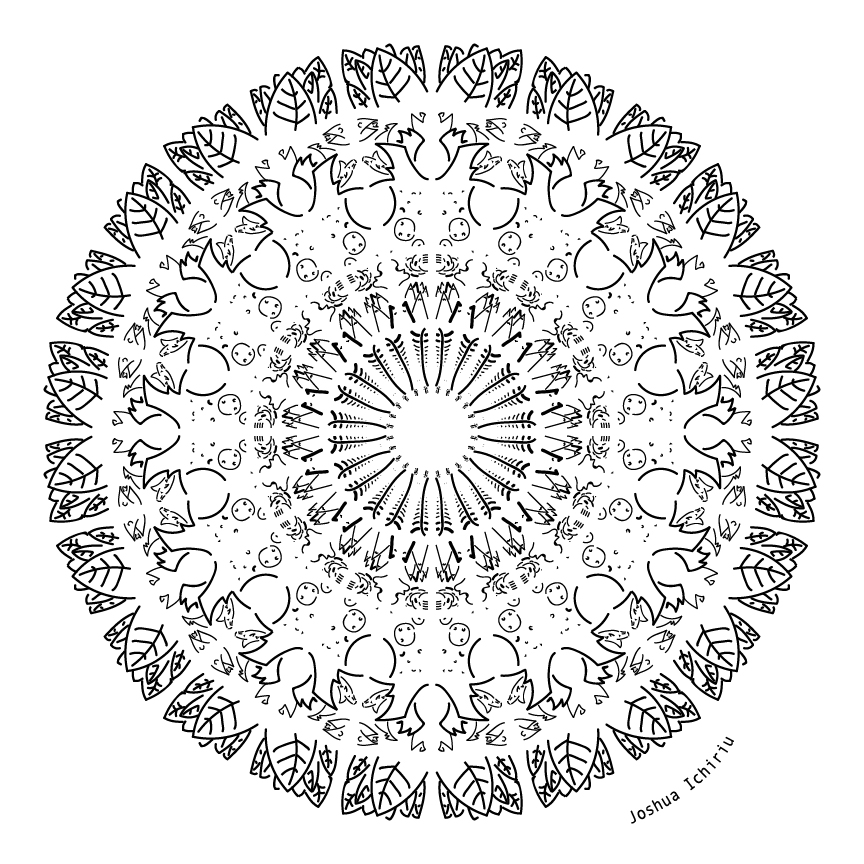
Colored Mandala
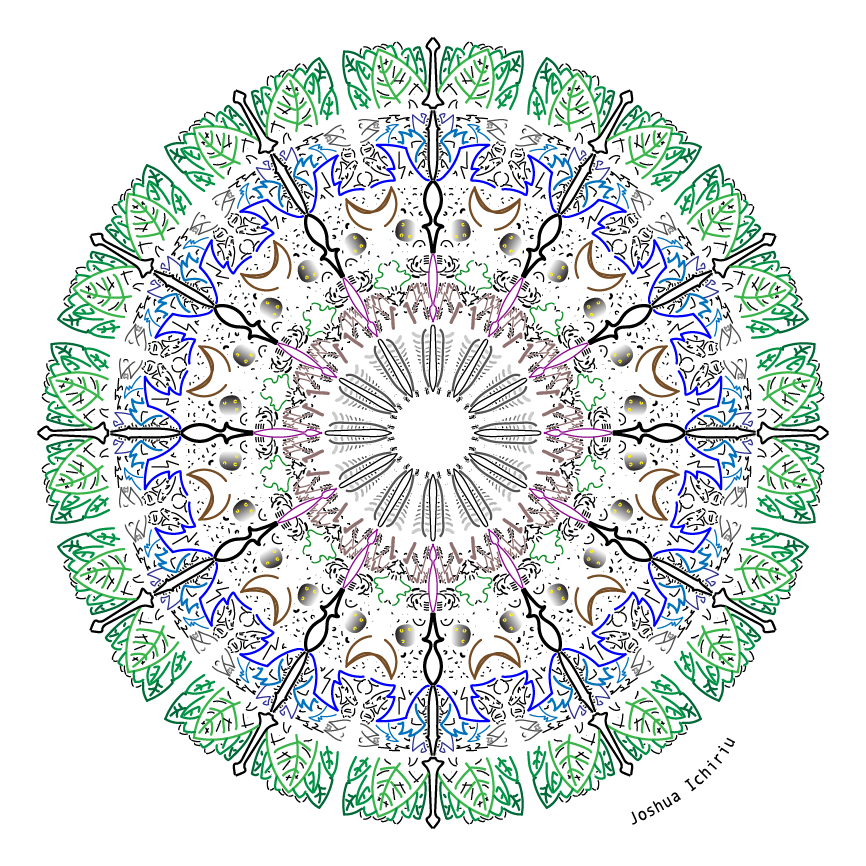
Build Video
My video is glitching so here is an url to my video: https://www.youtube.com/watch?v=BK-Sp0mgVoU&list=PL4UmbWlij-uRxU5EWvfONYSgtCses5TsS&index=29&ab_channel=FreestyleAcademy
Mandala Printed Mandala Video

Artist Statement
When I learned about the Mandala assignment, I was confused and unsure of what a mandala was and why we were building one. I quickly learned when I started constructing the mandala on illustrator, as it allowed me to combine my art skills with my interests outside of the classroom. Building the mandala also taught me how to relax in my art. The process of watching my patterns and ideas spread out into a full circle was extremely satisfying. What helped spark my creativity was when I made the transition of thinking of the Mandala as a classwork assignment to my personal design.
When I built the Mandala, I learned what was valued to me. I chose to draw nature, which is a way for me to relax especially during quarantine. From bottom to up, I have feathers, mountains, space, ocean, then leaves. I realized how much nature reflected who I am as a person, and my Mandala is a reflection of my love for nature. I hope to produce more mandalas similar to what I was able to build in the future.
This I Believe
In English Class, we wrote an essay about something that we held true to ourself and believed in. I wrote my essay on helping others.
My video is glitching so here is an url to my video: https://www.youtube.com/watch?v=2s_DVmmhbH8&list=PL4UmbWlij-uRxU5EWvfONYSgtCses5TsS&index=91&t=16s&ab_channel=FreestyleAcademy
It took me years to figure out how spoiled I truly was. I’ve never gone a day without food on the table, having a bed to sleep in, or a roof to stay under. From the sole fact that I was born in Silicon Valley, I was blessed with a better life than many others. I was situated inside a bubble where everybody surrounding me was the same.
When I traveled to Indonesia with my family in 6th grade, I remember driving along the crowded streets in a taxi. When I looked to my right, I saw a bustling supermarket selling Indonesian bananas and mangoes but to my left, I saw shirtless children standing on the side of the road, holding broken glass bottles begging for money from the drivers on the road. Sitting patiently at their side were stray dogs, so starved you could see their bones protruding out of their thin skin. When I watched these children, who were no older than me, fight for their next meal and a glass of clean water to drink, I realized a belief I hold to this day, that I should take the gifts I have been blessed with in order to help others.
These experiences have made me explore helping others in my community. From donating blankets and food to wildfire victims or involving myself in community service organizations, I do my best to give back to society. One time, when I volunteered at the Sunnyvale Homeless Shelter, I learned that many of the homeless in the shelter were former teachers, engineers, and members of the army. When I was in the shelter, I began to understand that by serving in the shelter, I’m giving back to people who had once helped me before.
Over time I began to realize helping others is more than donating money, but about spending time and building relationships with the people I meet. In 8th grade, I began working with students with disabilities in my church, ranging from autism to ADHD. I get joy from watching these kids grow and knowing the influence I can bring into their lives. I have seen them become more open, positive, and hopeful over the 4 years I have spent with them.
From helping fire victims to building relationships with special needs students, my eyes have been opened to the range of people I could help with what I have. I’ve been blessed with so many gifts, and I know it’s my job to give back to others.
College Personal Essay
For this project, I finished my college personal essay in class. With help from Mr. Greco, I was able to complete my assignment and create a well written essay about my experience with Special Needs Students and Music.
Something about Aaron’s stomping feet and fidgeting alerted me to the brewing storm, and my muscles instinctively tensed up, braced for action. We were both newcomers: Aaron, a second-grader with autism, was attending his first regular Sunday School class; and I, a ninth-grade volunteer, was assigned to help him make it through the day. As we walked into the classroom, I noticed Aaron freeze under the intense gaze of twenty pairs of eyes, so I quickly took his hand and comforted him with a gentle, “It’s ok”. As he gradually relaxed his shaky grip, I breathed a sigh of relief. My fear began to fade, I nodded at him encouragingly, and we walked into the classroom together.
My ability to connect with people began on the violin when I was 6 years old. I learned how to express my emotions—portraying sad scenes with a slow, sorrowful vibrato, or using short, forceful strokes to depict energetic scenes. It’s immensely satisfying to see my audience captivated when my music successfully conveys the mood of the pieces. In high school, I joined classical orchestras, string quartets, jazz bands, and actively listened to the other instruments to play together. I learned the importance of non-verbal cues between musicians—a cellist’s raised eyebrow, a singer’s wave of the hand, or the conductor’s tap of a baton—to merge our individual parts into a beautiful ensemble. Music has trained me to pay attention to feelings and body language, giving me a heightened sensitivity to the emotions of others.
This sensitivity allowed me to hear the unspoken needs of my autistic students in our church’s Special Needs respite ministry. Putting myself in their shoes, I pictured not being able to interpret social situations and, as a result, responding inappropriately. As many of my students have difficulty expressing themselves, I watch their body language to understand how they’re feeling and how to make them feel safe and secure. At first, when Anthony, who has extreme ADHD, started throwing papers on the floor and galloping around the classroom, I could only calm him by letting him read a book—his favorite activity. But I have learned that by carefully watching for his eyes darting around the room and hands beginning to clench, I can intervene with some calming words before he loses control. And when Christopher, who is non-verbal, walks into the room with his eyes downcast, I know that he needs a cheerful smile and positive energy.
I have discovered that my empathy empowers me to successfully collaborate with others by recognizing and addressing interpersonal issues effectively. When I attended the Summer Electronic Music Institute Program at NYU this summer, we were assigned to work in small groups, composed of students from around the country with different musical backgrounds. One of my group members never joined during our discussion or contributed to our composition initially. I felt that he wasn’t comfortable sharing his music, possibly because the virtual format made it hard for him to relate to us. Sensing his reluctance to participate, I decided to share my musical ideas for his feedback first. To encourage him to open up, I sent him drum loops and chord progressions and asked for his help. Soon enough, he reciprocated, adding melodies to my chords. Together, we produced an exceptional song, incorporating ideas from the entire group. I still collaborate frequently with many kids from SEMI to this day, and we enjoy writing tunes with each other.
I’ve seen the impact that approaching others with sensitivity can have: thanks to the time we’ve spent together, Aaron now loves being around others and goes out of his way to say hello to me even whenever he sees me on Sunday mornings. In college, these skills will help me encourage participation, solve interpersonal conflict, and rally people together to address bigger challenges.
Lastly in English (Honors), we created a memoir essay. My memoir choice was On Writing, by Stephen King.
“You should avoid the passive tense … The passive voice is safe.” (King 122) By refusing to use passive tense, world-renowned author, Stephen King, propels readers into a world of his own, an emotional journey filled with sickness, rejection, and pain in “On Writing: A Memoir of the Craft. Throughout his life, King dealt with infections, anxiety, alcoholism, and accidents while trying to chase his dream of being a writer. Throughout the book, King reflects on stories from his life, consistently opening with vulnerability in order to lead us to his four core values: perseverance, maturity, self-control, and patience.
In the story, King sends us back to Maine during his teenage years, in his room where he is working writing his latest stories, hoping to strike it big someday with a publisher. As an aspiring writer, King enthusiastically sends his stories to countless publishers, but receives many rejection letters, so much that the “the nail in my wall would no longer support the weight of the rejection slips impaled upon it.” (King 41) King takes the rejection slips as motivation, pushing him to work harder and continue to develop his stories until finally, he begins selling his stories to magazines. King’s constant persistence in achieving his goals opens our eyes to his core value of perseverance. Through this process of sending out his stories, we watched Stephen King fail to succeed countless times. His mixture of vulnerability and growth throughout the book bring us closer to King and creates a connection between the reader and author.
Later in King’s life, he begins to struggle with alcohol and drug addictions. King’s alcoholism begins to affect his writing, as he unknowingly begins to write his stories about his struggles with alcoholism. “Holy shit, I’m an alcoholic, I thought, and there was no dissenting opinion from inside my head—I was, after all, the guy who had written The Shining without even realizing that I was writing about myself.” (95) His battle with substances not only affects his writing but his relationship with his family, as his wife, Tabitha, who threatens to leave him if he can’t get control of himself. “Tabby said I had my choice: I could get help at a rehab or I could get the hell out of the house” (King 97) King strengthens his story by being vulnerable, opening up about private struggles he encounters. Because we are able to gain a deep perspective into his life, readers are able to understand and connect with King, further developing his memoir. Years later in the story, we watch King begin to mature, growing as a person and realizing how his addictions have consumed his life. He writes, “At the worst of it I no longer wanted to drink and no longer wanted to be sober, either. I felt evicted from life. At the start of the road back I just tried to believe the people who said that things would get better if I gave them time to do so. And I never stopped writing. Some of the stuff that came out was tentative and flat, but at least it was there. I buried those unhappy, lackluster pages in the bottom drawer of my desk and got onto the next project.” (King 99) He watched his alcoholism deplete his life in the real world, but instead fought back, continuing his passion for writing and watching writing pull him out of his addictions. As King begins his story with vulnerability and transitions into his core value of maturity, we watch King open up and evolve as a person.
While King’s alcohol abuse teaches him how to mature, it also helps him discover the passion he has for writing. Originally, King shared the struggles he faced with his writing, discovering that his recent writing wasn’t as authentic as it had been before. As he matures and moves off of alcohol, he grows more passionate about his projects he creates. In order to become a better writer, he values the importance of developing his own space. He begins reconstructing his room, starting by replacing his workspace, an old child’s toys table, for a new wooden desk and a Turkish rug. As he begins to write frequently, he sees fruits begin to blossom outside of work, as he starts spending more time with his family, realizing how much he loves spending time with his children. Throughout the story, Stephen King displays his core value of passion for writing, and he soon realizes that “Life isn’t a support-system for art. It’s the other way around.” (King 101)
Lastly, later in King’s life, he illustrates the story of a fatal incident he experiences at the age of 51. While walking home, he is struck by a minivan and is left lying in a ditch, barely able to make it out alive. He breaks his legs, bones, and is cut in many areas of his body, needing 20-30 stitches in his scalp. During the recovery process, King becomes discouraged and believes his chances at survival are slim, asking the paramedic twice if he was going to die, questioning if he was paralyzed, and later asking a different paramedic to tell his wife that he loved her after his lung collapsed while being transported in a helicopter. Through this process, we learn how King develops patience during this difficult period. “I came home to Bangor on July ninth, after a hospital stay of three weeks. I began a daily rehab program which includes stretching, bending, and crutch-walking. I tried to keep my courage and my spirits up. On August fourth I went back to CMMC for another operation.” (King 264) He was able to regain some of his former self through this process, while being in a wheelchair, he is able to regain control of his muscles and legs. Through this example, the readers see Stephen King express his core value of patience, as during this process, he managed to maintain patience while recovering from a horrific accident.
In On Writing: A Memoir of the Craft, Stephen King draws the reader in with his mixture of vulnerability and expression of four core values: self-control, perseverance, maturity, and patience. Through King’s rollercoaster of a life, he has discovered traits that have defined and created him into the author he is today while continuing to express an important theme in writing, vulnerability. Overall, King uses his core values and vulnerability to create an impactful memoir, and with every example and story serving to bring the reader closer to his own life.
After Effects
Here is an after effects file. I used multiple effects to put together this project.

Photoshop Art Section
I used many photos to put together this Photoshop Art Section. I learned how to paint using my Wacom, piece together pictures, and create art.
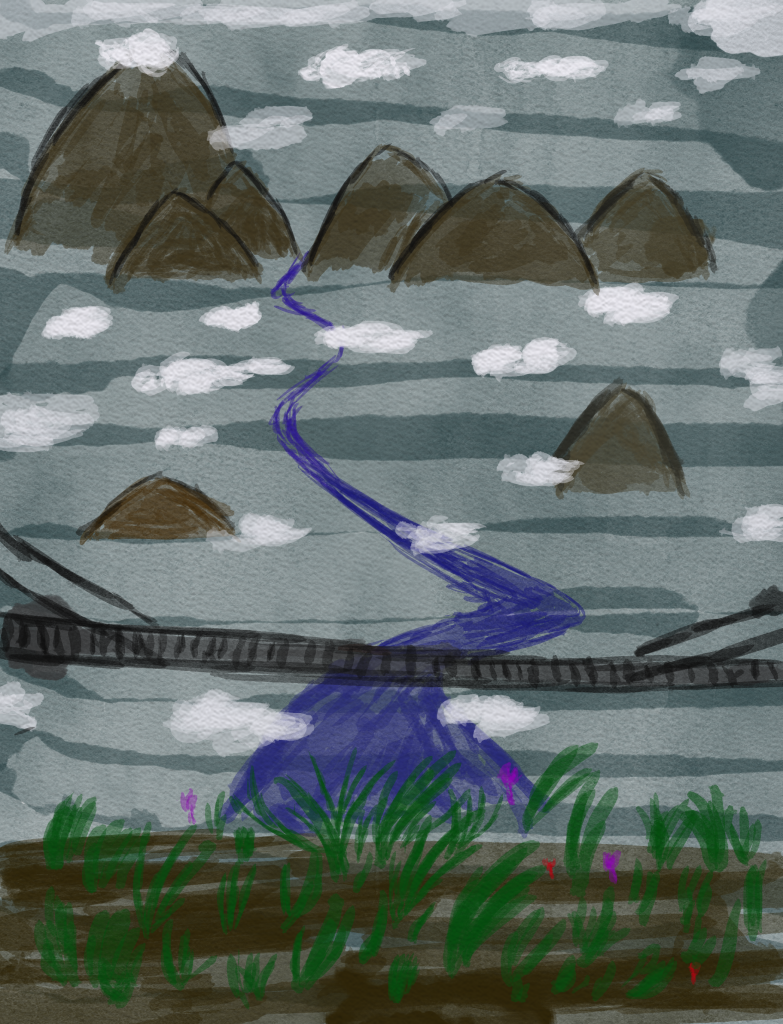
During the creation of my photoshop watercolor painting, I learned how to express my ideas through painting. At first, I was skeptical of Photoshop’s ability to create watercolor paintings, but as I practiced and played with the program I knew it was capable of creating whatever I had in mind. If I can change anything about my painting, it would be to vary my brush strokes to create more diversity in my painting. As a design student, I can take this new found skill I developed in Digital Media and apply it to my Design courses. Now, I have a newfound appreciation for art and specifically watercolor painting. I know what it takes to produce an interesting drawing and hope to continue my production of watercolor paintings into the future.
Here is a collection of Paintings and photos I created in Digital Media.


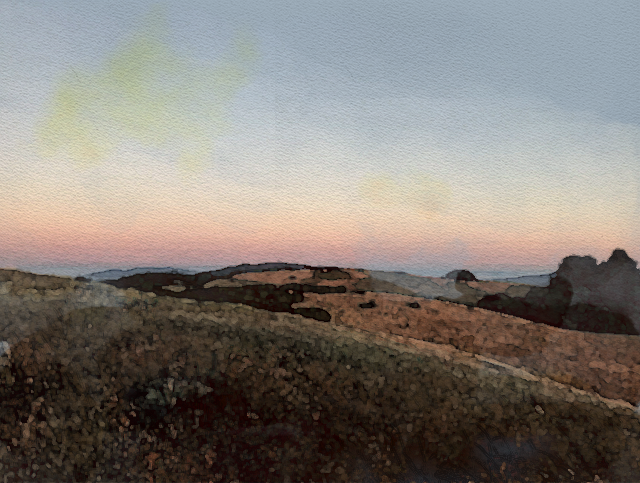





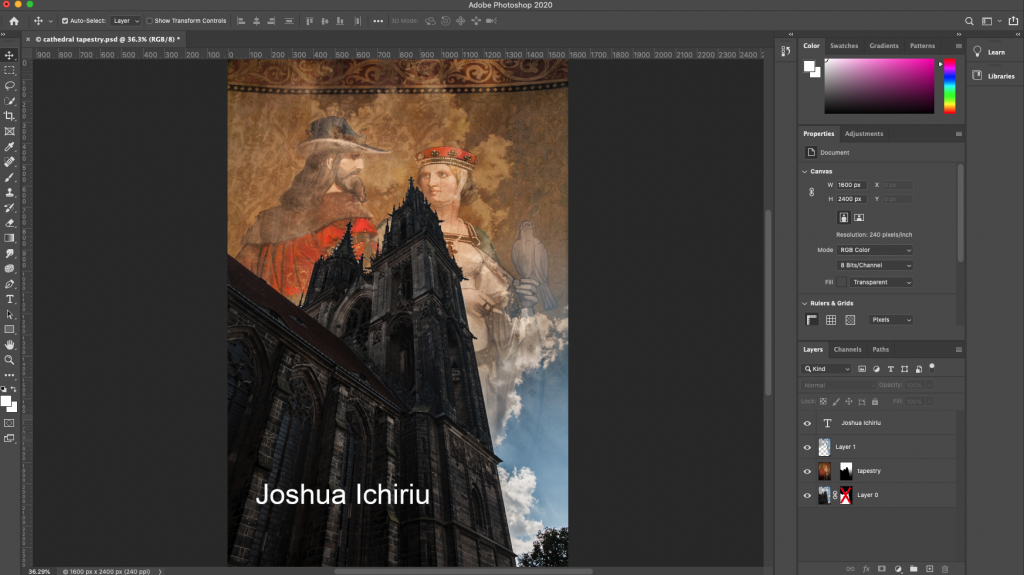

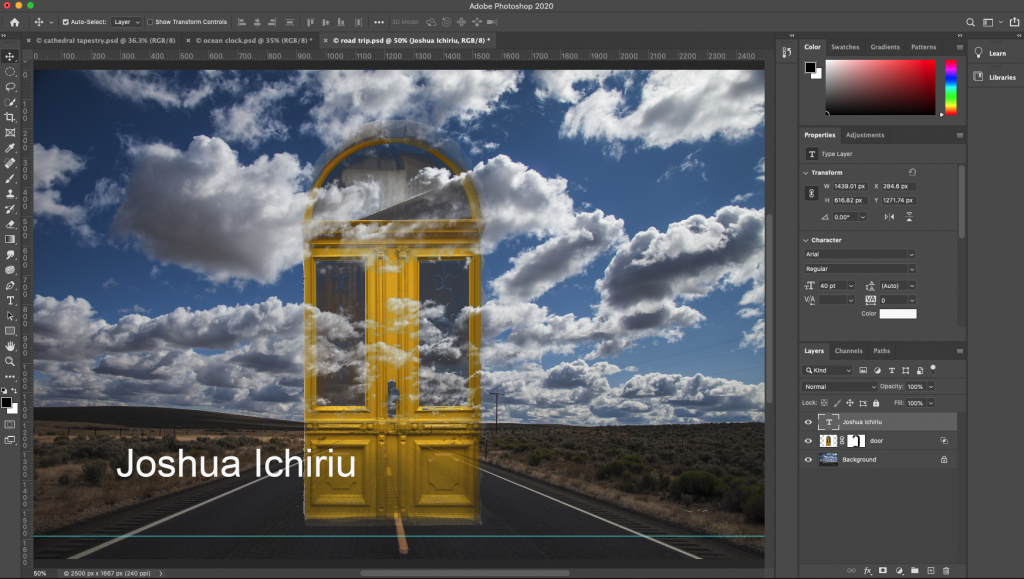
Design
In Design Class, we learned how to create our own PSAs, Elements of Art within design, and develop bring understand basic techniques in photography. Below, I will show my PSA, and PSA Artist statement.
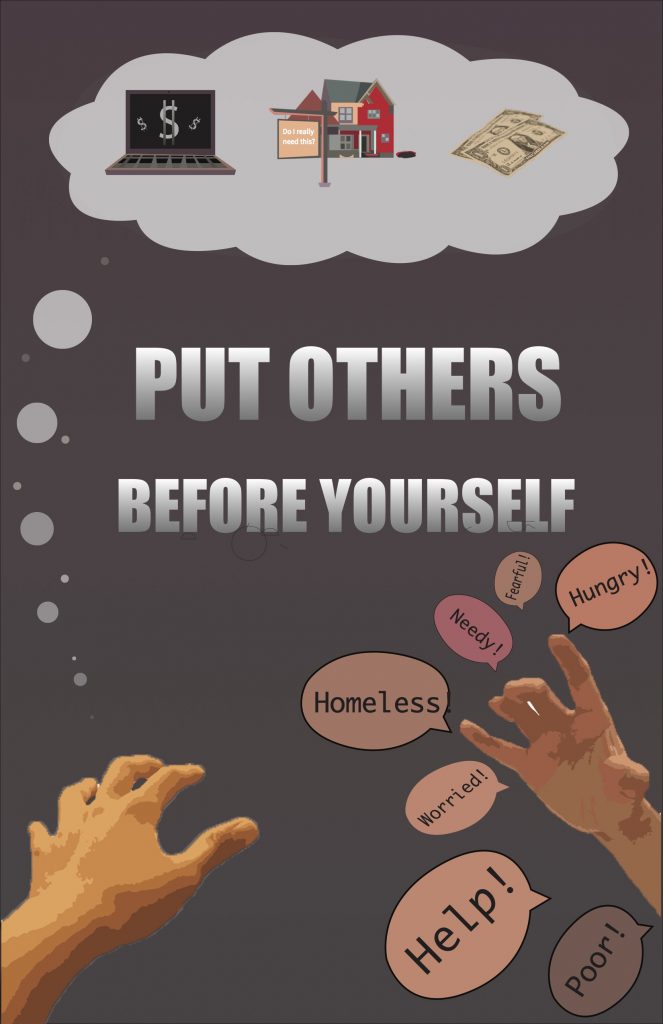
Artist Statement
In this PSA, I expressed a message I believe in, to “Put others before yourself”. Upon working on this PSA assignment, I instantly knew I wanted to spread this message because it is something I see in my community. I have always believed in putting others before yourself. In this PSA, I drew two hands facing each other, one surrounded with bubbles with the words, “Help!”, “Hungry!”, “Needy!” and more. On the other hand, I represented that person to be thinking by drawing a thinking bubble over the hand, with a new computer, a new house, and money inside of the bubble. In the center of the PSA, the words “Put Others Before Yourself” are capitalized and display the message. I used the color scheme of Dominant #DB252F (Red), #573F4B (Purple), #F08C7F (Pink), #DB9179 (Pink), #FAB991 (Orange), to create my illustration. I used these warm colors to match my hands, a light brown/orange color.
I began by photographing my hands and importing them into Illustrator. I used the image trace tool to draw hands, the house, and the computer, and took pictures of the money (again using the image trace function to create a photograph). Lastly, I wrote text in the center to display my message, and after creating outlines for the text I was able to put a white to gray gradient on the font. This PSA helped me discover how I could express my thoughts in art and how I can use Illustrator in the future to design and create more powerful PSAs.
Thank you so much for visiting my website!